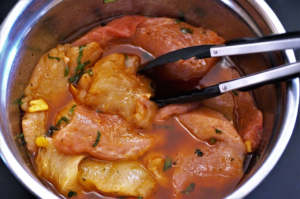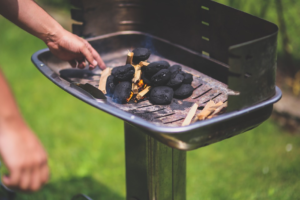With the onset of the summer season, temperatures continue to rise higher and you may begin to wonder what kind of fun activities can be done to pass the time. Do you have an open backyard? Are you planning to host a party? Then having a live grill to serve your guests exceptional food while the kids play games and the adults chit-chat is a great way to celebrate those rare holidays with your family and friends. Grilling is considered a community event in many parts of the world because it brings people together with the same tastes, allowing them to eat and socialize.
Grilling is a great way to infuse more flavor into your veggies and meats. This is because the fat from the meat renders and glazes it while tenderizing it. So, not only is it a great flavor enhancer, but it also adds a rustic roast taste that makes it unique and delicious. In addition, many enjoy the experience of watching live cooking happen, especially when it comes to playing with fire.
While having the community spirit and trying out cooking on a grill maybe adventurous, it comes with certain dangers that should be avoided, especially when there is company around to distract you from your task. However, grilling is a doable job if you know how to go about it. With a bit of knowledge and hard work, you could be cooking meals that will have people talking during every summer party you host afterward. In this article, we provide you with plenty of grilling tips for summer cookouts.

Table of Contents
The Charcoal vs. Gas Debate
One of the most debated conversations about grilling has been about what to use to fire up your grill: gas or charcoal? Pro-chefs who have been grilling for decades seem to favor the side they think adds more flavor. Gas-powered grills are favorable for those grilling indoors or who live in cities with limited backyard spaces. There is no smoke, and it is possible to run the grill without restocking and refueling constantly. Not only that, but gas-powered grills are generally preferred by those who are environmentally conscious since the fuel burns clean.
On the other hand, charcoal-powered grills are a fan favorite for those who enjoy the charred flavor in their meat and vegetables. The smoky flavors make the food a better meal to enjoy in terms of taste. However, in other regards, it does have its downsides. Charcoal grills are high-maintenance grills. They have to be restocked and refueled for every round of grilling to fuel the flames. They dirty the grills with the smoke and the grease deposit, which requires the grill to be cleaned after every use. It also produces carbon monoxide, which is dangerous to inhale, especially indoors. This limits its use in open spaces indoors. Lastly, it is not environmentally friendly since it doesn’t burn clean.
Prepare Your Grill
Any meal cannot be cooked without preparing the essential ingredients for it beforehand. Here are some tips to prepare.
Keep Your Workstation Clean
Before you start cooking, wash your hands! Hands carry germs and bacteria that can contaminate the food; therefore, it is crucial to wash your hands before starting the cooking process. Wash your hands with soap and water. Also, make sure that all the utensils and work surfaces have been cleaned thoroughly to avoid the risk of food poisoning.
Wash Everything
Rinse all your vegetables before cutting them for your meals because crowded marketplaces and stores can expose them to germs and bacteria.
Avoid Cross-Contamination
When dealing with meat, seafood, eggs, and poultry products, you have to be very careful of cross-contamination as these food types harbor a lot of foodborne bacteria. Ensure you have clean cutlery to prepare the meats and keep separate cutting boards and knives for use. All food types should also be categorically separated when being stored in the refrigerator.
Ensure that the kitchen is not overcrowded with too many people, as it is said, “Too many chefs spoil the broth.” If too many people are involved in the cooking process and handling the meats, then the risks of cross-contamination become higher. Keep the raw meats away from prying hands.
Keep Meat in Coolers
Cool the meats, poultry, and seafood in either an icebox or bury them in ice packs to regulate their temperature. If you have a cooler box, then don’t use it frequently, as the temperature inside can be destabilized by frequent use. The cool air is also let out in the process and it traps hot air in.
Grilling Guide
Marinate The Meats

A natural way to enhance the flavor is to infuse it with flavors by letting it marinate. Depending on the meat, the period of marination varies. For example, seafood can be marinated for 15 to 30 minutes for the shortest time, whereas meat can be marinated for up to 45 days. It is best said to let dark meats marinat for at least two days for the taste to be optimised. But remember not to let it rest for too long, as extended marination time can make the meat start to deteriorate.
Grilling

If you are going to start grilling your ingredients, equip yourself with the proper tools to help make the process easier. You should have the following grill tools: grill brush to clean the grill, silicone brush to lather the meats with the marinating sauce, a meat thermometer to check the meats’ internal temperature, plates to put the dish on, and flipping utensils should be kept ready.
Different foods have different internal temperatures, so update yourself with them before you start cooking.
- 65°C for chunks of dark meat such as beef, pork, and lamb
- 72°C for meat such as beef and pork
- 73°c for chicken and turkey
- 62°C for fish
The color, smell, and texture of the meat are the best visual indicators of the food being well-cooked and ready to eat. Be vigilant while cooking to avoid overcooking the meat, as it will make it chewy and rough.
Temperature Control
If you are cooking outdoors, take precautions so your ingredients do not spoil under the summer heat. For example, it is wise to take out portions of ingredients instead of pulling them all out at once. Also, it is better to set up an umbrella to have shade for all the veggies so they do not spoil. Coolers can be stored in ice boxes too. Finally, if there are hot dishes that have been prepped, keep them indoors and let them sit at room temperature so as not to spoil under the scorching sun.
Leftovers
Many times when we cook, we overestimate people’s eating abilities or end up making too much stuff that might go to waste. Since we don’t like food waste, we advise that you reserve your food as leftovers. The best way to preserve food is by refrigerating it and consuming the food within three to four days. Then, you can reheat the food either in the microwave or using a gas stove whenever you feel hungry.
Although it may be a bit of a drag to take on the role of cookout safety monitor, knowing better means doing better. So be as annoying as it takes, and refer folks to this article if they try to give you a hard time inspecting chicken with a thermometer or putting those leftovers away a little earlier than usual. Ensuring your guests are served food that’s safe to eat is just as important as how it tastes.
So now that we have given you the proper tips, wear your chef’s hat and get to work hosting your next party.
